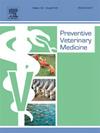塞内加尔小型反刍动物动物疾病负担的经济评估。
IF 2.2
2区 农林科学
Q1 VETERINARY SCIENCES
引用次数: 0
摘要
撒哈拉以南非洲地区的小反刍动物生产受到一系列制约因素的限制,其中包括动物健康问题。本研究旨在利用全球动物疾病负担(GBADs)计划开发的方法,全面估算这些问题对塞内加尔小反刍动物生产的影响。估算的重点是作物-牲畜混合系统,该系统占该国小反刍动物总数的很大比例(>60%)。该估算基于通过系统文献回顾收集的现有数据、从当地利益相关者处获得的二手数据集以及专家意见征询。采用动态种群模型计算了在当前健康限制条件下和理想健康状态下(即动物不会受到发病和死亡原因的影响)该行业的毛利率。当前健康状况与理想健康状况之间的差额称为动物健康损失封套(AHLE),它提供了系统中农场一级疾病成本的定量衡量标准。据估计,在 2022 年,880 万头牲畜的全因 AHLE 为每年 2920 亿非洲金融共同体法郎(4.68 亿美元,95 % 预测区间为 2160-366 亿非洲金融共同体法郎)。单独模拟了小反刍兽疫(PPR)的影响,作为将部分 AHLE 归因于特定疾病的一个例子。据估计,小反刍兽疫占 AHLE 总量的 5%。塞内加尔牲畜饲养者承受的动物疾病负担主要是由于牲畜和产量的损失,而动物保健支出相对较少。这项研究的实施有助于进一步发展 GBADs 方法。从国际层面的投资决策到针对牲畜饲养者的地方疾病宣传活动,这些估算结果都能为各级决策提供支持。本文章由计算机程序翻译,如有差异,请以英文原文为准。
Economic assessment of animal disease burden in Senegalese small ruminants
Small ruminant production in sub-Saharan Africa is limited by a range of constraints, including animal health issues. This study aimed at estimating the impact of these issues on the small ruminant production in Senegal in a holistic manner, using an approach developed by the Global Burden of Animal Diseases (GBADs) programme. The estimation focused on the mixed crop-livestock system, representing a large proportion (>60 %) of the small ruminant population in the country. It was based on existing data collected via a systematic literature review, acquisition of secondary datasets from local stakeholders, and expert elicitation. A dynamic population model was used to calculate the gross margin of the sector under both the current health constraints and an ideal health state, where animals are not exposed to causes of morbidity and mortality. The difference between the current and ideal health scenarios, termed the Animal Health Loss Envelope (AHLE), provides a quantitative measure of the farm-level cost of disease in the system. The all-cause AHLE was estimated at 292 billion FCFA (468 million USD, with 95 % prediction interval 216 – 366 billion FCFA) per year for 2022, for a population of 8.8 million animals. The contribution of Peste des Petits Ruminants (PPR) was modelled separately, as an example of attributing part of the AHLE to a specific disease cause. PPR was estimated to contribute 5 % of the total AHLE. The animal disease burden experienced by Senegalese livestock keepers was largely due to loss in animals and production, with relatively small amounts of animal health expenditure. Implementation of this study contributed to the further development of the GBADs approach. Such estimates can support decision making at all levels, from investment decisions at the international level to local disease awareness campaigns targeting livestock keepers.
求助全文
通过发布文献求助,成功后即可免费获取论文全文。
去求助
来源期刊

Preventive veterinary medicine
农林科学-兽医学
CiteScore
5.60
自引率
7.70%
发文量
184
审稿时长
3 months
期刊介绍:
Preventive Veterinary Medicine is one of the leading international resources for scientific reports on animal health programs and preventive veterinary medicine. The journal follows the guidelines for standardizing and strengthening the reporting of biomedical research which are available from the CONSORT, MOOSE, PRISMA, REFLECT, STARD, and STROBE statements. The journal focuses on:
Epidemiology of health events relevant to domestic and wild animals;
Economic impacts of epidemic and endemic animal and zoonotic diseases;
Latest methods and approaches in veterinary epidemiology;
Disease and infection control or eradication measures;
The "One Health" concept and the relationships between veterinary medicine, human health, animal-production systems, and the environment;
Development of new techniques in surveillance systems and diagnosis;
Evaluation and control of diseases in animal populations.
 求助内容:
求助内容: 应助结果提醒方式:
应助结果提醒方式:


